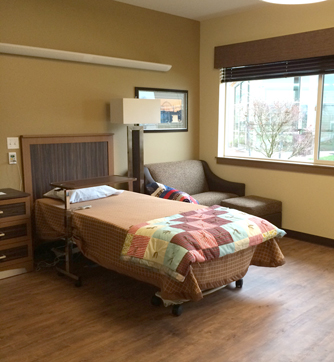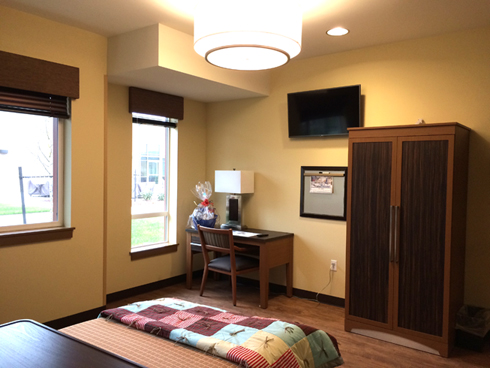The Edward C. Allworth Veterans’ Home is the second veterans’ home in Oregon and one of the newest in the country, having received its initial state license in December 2014, and federal Veterans Affairs recognition in March 2015.
How They Made It
The Allworth Home, most often referred to as the Oregon Veterans’ Home in Lebanon (OVHL), is already changing the perception of veterans’ facilities across the nation with its unique architectural design and operating model.

Organized around the idea of an intentional community or neighborhood, this new veterans’ center offers residents a way to maximize normal living environments and routines and provides autonomy, a sense of community, and a high quality of life.
OVHL’s 12-acre campus consists of four neighborhoods with 11 Small Homes being the main architectural feature of the campus. The homes are accessible and adaptive; designed for ease of movement; and feature open kitchens, dining areas where family-style meals are served, a living room with a fireplace, and private bedrooms/baths for 14 veterans.
They are supported by a community center that houses a large activity room, commercial kitchen, canteen, therapy gym, barber shop, and other support services. The campus has a capacity for 154 residents (veterans, spouses of veterans, and Gold Star Parents) with 42 rooms dedicated to memory care needs.
There are three main characteristics of OVHL that serve to make it a special place to live and work: The Small Home design, the use of the Universal Worker care model, and a stewardship-conditions leadership model that encourages staff to be self-directed and intrinsically motivated.
Featured Amenities
There has been much written about the Green House® and generic Small Home designs. The benefits are numerous and varied, depending on specific design features and amenities of the particular home.
OVHL’s homes have rooms that are functionally similar to a traditional nursing home but do so in a way that more resembles a noninstitutional bedroom.
The centerpiece to the room is the bed: The frame is a fully electric, hospital-grade model with a 42” x 84” pressure-relieving mattress. With a population of approximately 80 percent men, the larger beds provide greater comfort and have shown to decrease falls from bed. The beds lower to 7” if necessary and do not have foot boards, to reduce the institutional look.
There is also a love seat hide-a-bed for use by out-of-town family at no cost. Each room is equipped with a phone with a unique number that can be direct-dialed from the outside, includes voice mail, and provides free long-distance service thanks to low-cost VoIP technology.
A ceiling lift extends from over the bed and into the bathroom for ease of transfers to the commode. Digital thermostats in each room allow the occupants to precisely control their own bedroom temperature. A medicine box is mounted on the wall near the entrance of each room and allows the facility to completely eliminate the use of medication and treatment carts, a classic institutional artifact.
Finally, every room has a desk and chair, TV, dresser, and armoire for residents’ comfort and convenience.
How It Is Structured
OVHL is owned by the Oregon Department of Veterans’ Affairs, and operated by Veterans Care Centers of Oregon (VCCO), a nonprofit company established to operate both Oregon veterans’ homes (the other is located in The Dalles).

This unique public-private partnership enables the state to save millions of dollars in payroll costs and gains the operational expertise of VCCO’s subcontractor, Westcare, which has decades of long term care management experience.
The partnership’s nursing model utilizes the Universal Worker concept with certified nurse assistants (CNAs) performing several functions: They provide direct care, lead activities, cook, plate, serve meals, and wash the residents’ personal clothes.
OVHL has a higher health care professional-to-resident ratio (1:4.66 on days, 1:9.33 on nights), which means a superior level of care day and night.
CNAs (affectionately called personal assistants at OVHL) do their own scheduling and work 12-hour shifts due to the less strenuous workload allowing them more days off. The center’s call-off frequency experience is far below most facilities, and its annualized turnover in the first year was 12 percent.
Providers regularly schedule house meetings to problem-solve issues and concerns of each home and brainstorm better ways to serve the veteran residents. During the fill-up there was a need to ultimately hire 150 CNAs, and they have served to be the best marketing tool, recruiting their peers. Most have worked in standard institutional nursing facilities and say they wouldn’t even consider returning to that setting.
Governing Themselves
The mission of OVHL is to “Honor veterans through delivery of person-centered care in an innovative Small Home setting.” To fully accomplish this mission, OVHL needed to adopt a unique leadership model to complement its unique architectural design and operating model.
While many organizations function in a leader-follower model, OVHL utilizes a stewardship-conditions model. Stewardship is focused on creating the conditions where individuals lead, govern, and motivate themselves. For this reason, those in supervisory capacities see themselves as more stagehand than performer, and they view and treat employees not as question marks but rather as answers to the daily problems and challenges in health care. It is an environment where employees are more player than pawn, and genuinely feel needed and necessary to the outcome.
An example of this in action is the self-directed work teams where the CNAs coordinate the activities of each home and the licensed nurse acts more like a coach than a charge nurse in a typical institutional skilled nursing facility. In the end, a steward’s greatest success, quoting the physician and educator Maria Montessori, is to be able to say, the people “are now working as if I did not exist.”
 Benefits Are Obvious
Benefits Are Obvious
The results speak for themselves. OVHL’s customer satisfaction reports show marks well above national averages and even best-in-class scores. Many of the veterans have resided in other congregate settings prior to coming to the Edward C. Allworth Veterans’ Home and rave about the amazing difference in level of quality, increased staffing, excellent food (available 24/7), meaningful activities, and overall facility comfort.
The significant advantage the Small Home model provides is private bedrooms/baths for each veteran resident, which forestalls so many problems.
Also, not to be overlooked, the Universal Worker model of care adds another dimension that provides increased employee satisfaction as well.
And, finally, the application of the stewardship-conditions leadership model completes OVHL’s culture and helps accomplish its vision of a creating a community where its veterans, families, and employees can thrive.
Kelly J. Odegaard, MBA, NHA, is administrator and Jeremy Woodall is program director at the Oregon Veterans’ Home in Lebanon. Odegaard can be reached at Kelly.Odegaard@ovhlebanon.org, and Woodall can be reached at jeremy.woodall@ovhlebanon.org.